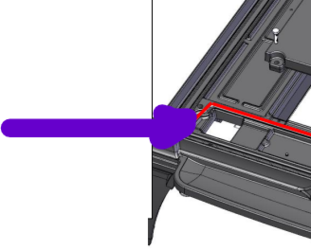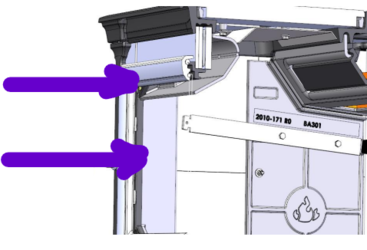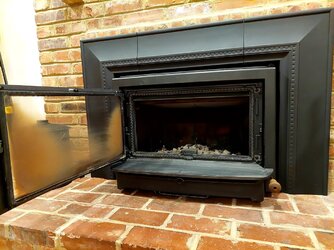Hearthstone Clydesdale II (8492) Review
Summary: Design flaws and poor quality control don't live up to the brand's reputation.
Last fall (2022) my wife and I purchased the Hearthstone Clydesdale TruHybrid (8492) insert to get a little bit of warmth out of our masonry fireplace. We went with this particular insert because it provided the largest viewing area of any EPA insert offered by our local dealer that would fit in our fireplace, we found it aesthetically pleasing, and we were assured by the dealer that Hearthstone was a good brand. After a full season of use we would rate is as an unqualified disappointment and encourage other prospective stove buyers to look elsewhere.
Issues with the stove:
1. The air wash. The draft sucks air in the the primary air intake, up through the side/front of the stove where it is warmed ever so slightly, and out over the top of the stove glass (see diagram attached). Testing with a smoke pen, realistically, the air wash only covers the left and right third of the glass. At lower draft (during the first 15 minutes of a fire) it tends to blow smoke rather than air over the glass. As a result, the left and right third of the glass quickly become opaque. The decision to use primary rather than secondary air means that when you close down the primary air intake for a long, smoldering burn, the middle of the glass will get sooty too. It also means the air never gets hot enough to burn off the soot. The sooty glass detracts from the enjoyment of the fire (see picture), and you will have to spend 15 minutes after each fire scrubbing with Rutland glass cleaner (once the glass has cooled down).
2. The secondary burn tubes. The Clydesdale 8192 hung secondary burn tubed underneath the baffle. The 8492 has a panel in the back of the stove to introduce secondary burn air. It's really only effective if you have a whole lot of wood in your stove and the primary air is open most of the way. You'll get to enjoy the rolling flames of a secondary burn some, but perhaps not as much as if you had secondary burn tubes on the baffle toward the front of the stove. In theory the catalyst will still convert the woodsmoke to heat, but it isn't as enjoyable to watch. In theory this new configuration makes it easier to change the baffles, but it also leaves the baffles more vulnerable to mechanical damages, ensuring that you *will* need to change them more often.
3. The primary air. It's kind of a laser beam in the middle bottom of the stove. It doesn't do a good job getting air to the corners of the stove on either side, which contributes to smoldering and sooty glass in the corners. If there's an East-West log near the front of the stove it blocks the air. Although you're not supposed to use a fire grate, it's easiest to get a fire going by building it on top of a couple of North-South logs so that the primary air can get up underneath the fire.
3. The draft requirement. This stove has a wide front and a narrow back. Unless you have a well-insulated, 33 foot, central chimney, you *will* get smoke in your house every time you open the door to reload.
4. Fiddley controls. Some owners have complained the catalyst temperature probe doesn't work. Mine works OK, but once you get the stove up to a consistent temperature (takes a few hours), you don't have a lot of margin for error between smoldering logs with no flame and overfiring. There isn't a lot of dynamic range in the primary air control. Be prepared to spend a lot of time fiddling with it. Part of the problem was Hearthston'e decision to line the stove with soapstone. Rarely does the stove get hot enough in enough places to burn the soot off of the soapstone, so it's not as if you'll get to see and admire it. It might have been better if they had chosen a firebrick material with a higher temperature limit.
5. Burn time. One of the theoretical advantages of a catalyst stove is the ability to damper down and generate heat overnight from a smoldering fire. In practical experience, if I fully load the stove and them damper down, I have about 6 hours in which I can add another log and get the fire to come roaring back. After than you will still get some heat, but the catalyst will cool below the active range and it will take some work to restart the fire.
6. Catalyst placement. The catalyst cannot be directly observed during stove operation. This makes it difficult to assess if the catalyst is successfully lighting off (normally you would look for the catalyst to glow). I see about the same amount of smoke coming out of my chimney with and without the catalyst. Taking the catalyst out it appears in clean, working order, but who knows if it's really doing anything?
7. No stovepipe damper. This is a problem for many EPA stoves, but it seems particularly noticeable for the Clydesdale. With the stove cool and the primary air control closed all the way I still get a cool draft down the chimney comparable to leaving a window open. If I had better draft, then I would simply be getting the same amount of cool air through some other hole in my house's thermal envelope and warm air going out up the chimney. This detracts from the energy efficiency of the stove. My solution is to remove the baffle, open the bypass door, and plug the flue with wool when not in use; this reduces the cool draft. But doing this every time I want a fire is no fun. The facade doesn't really leave clearance to install a stovepipe damper or a linkage to control it.
8. Build quality. As mentioned by other owners, when the stove is hot the catalyst bypass control lever can become stuck. This is an intermittent issue, so I haven't been able to get my dealer to do anything about it. Another quality issue I've noticed is that, after one year of use, the fiberglass gasket on the bypass door has fallen off. With some contorting I was able to get it back on with stove cement.
I've posted about some of these issues separately and gotten feedback along the lines of: your draft is no good, the stove isn't getting hot enough, your wood is too green, you don't know what you're doing, etc. After a full year with this stove, buying a moisture meter, buying a stove thermometer, buying kiln dried wood, etc, I can assure you the problem is the insert. Whether these are problems with my specific insert or the Clydesdale in general I cannot know.



Summary: Design flaws and poor quality control don't live up to the brand's reputation.
Last fall (2022) my wife and I purchased the Hearthstone Clydesdale TruHybrid (8492) insert to get a little bit of warmth out of our masonry fireplace. We went with this particular insert because it provided the largest viewing area of any EPA insert offered by our local dealer that would fit in our fireplace, we found it aesthetically pleasing, and we were assured by the dealer that Hearthstone was a good brand. After a full season of use we would rate is as an unqualified disappointment and encourage other prospective stove buyers to look elsewhere.
Issues with the stove:
1. The air wash. The draft sucks air in the the primary air intake, up through the side/front of the stove where it is warmed ever so slightly, and out over the top of the stove glass (see diagram attached). Testing with a smoke pen, realistically, the air wash only covers the left and right third of the glass. At lower draft (during the first 15 minutes of a fire) it tends to blow smoke rather than air over the glass. As a result, the left and right third of the glass quickly become opaque. The decision to use primary rather than secondary air means that when you close down the primary air intake for a long, smoldering burn, the middle of the glass will get sooty too. It also means the air never gets hot enough to burn off the soot. The sooty glass detracts from the enjoyment of the fire (see picture), and you will have to spend 15 minutes after each fire scrubbing with Rutland glass cleaner (once the glass has cooled down).
2. The secondary burn tubes. The Clydesdale 8192 hung secondary burn tubed underneath the baffle. The 8492 has a panel in the back of the stove to introduce secondary burn air. It's really only effective if you have a whole lot of wood in your stove and the primary air is open most of the way. You'll get to enjoy the rolling flames of a secondary burn some, but perhaps not as much as if you had secondary burn tubes on the baffle toward the front of the stove. In theory the catalyst will still convert the woodsmoke to heat, but it isn't as enjoyable to watch. In theory this new configuration makes it easier to change the baffles, but it also leaves the baffles more vulnerable to mechanical damages, ensuring that you *will* need to change them more often.
3. The primary air. It's kind of a laser beam in the middle bottom of the stove. It doesn't do a good job getting air to the corners of the stove on either side, which contributes to smoldering and sooty glass in the corners. If there's an East-West log near the front of the stove it blocks the air. Although you're not supposed to use a fire grate, it's easiest to get a fire going by building it on top of a couple of North-South logs so that the primary air can get up underneath the fire.
3. The draft requirement. This stove has a wide front and a narrow back. Unless you have a well-insulated, 33 foot, central chimney, you *will* get smoke in your house every time you open the door to reload.
4. Fiddley controls. Some owners have complained the catalyst temperature probe doesn't work. Mine works OK, but once you get the stove up to a consistent temperature (takes a few hours), you don't have a lot of margin for error between smoldering logs with no flame and overfiring. There isn't a lot of dynamic range in the primary air control. Be prepared to spend a lot of time fiddling with it. Part of the problem was Hearthston'e decision to line the stove with soapstone. Rarely does the stove get hot enough in enough places to burn the soot off of the soapstone, so it's not as if you'll get to see and admire it. It might have been better if they had chosen a firebrick material with a higher temperature limit.
5. Burn time. One of the theoretical advantages of a catalyst stove is the ability to damper down and generate heat overnight from a smoldering fire. In practical experience, if I fully load the stove and them damper down, I have about 6 hours in which I can add another log and get the fire to come roaring back. After than you will still get some heat, but the catalyst will cool below the active range and it will take some work to restart the fire.
6. Catalyst placement. The catalyst cannot be directly observed during stove operation. This makes it difficult to assess if the catalyst is successfully lighting off (normally you would look for the catalyst to glow). I see about the same amount of smoke coming out of my chimney with and without the catalyst. Taking the catalyst out it appears in clean, working order, but who knows if it's really doing anything?
7. No stovepipe damper. This is a problem for many EPA stoves, but it seems particularly noticeable for the Clydesdale. With the stove cool and the primary air control closed all the way I still get a cool draft down the chimney comparable to leaving a window open. If I had better draft, then I would simply be getting the same amount of cool air through some other hole in my house's thermal envelope and warm air going out up the chimney. This detracts from the energy efficiency of the stove. My solution is to remove the baffle, open the bypass door, and plug the flue with wool when not in use; this reduces the cool draft. But doing this every time I want a fire is no fun. The facade doesn't really leave clearance to install a stovepipe damper or a linkage to control it.
8. Build quality. As mentioned by other owners, when the stove is hot the catalyst bypass control lever can become stuck. This is an intermittent issue, so I haven't been able to get my dealer to do anything about it. Another quality issue I've noticed is that, after one year of use, the fiberglass gasket on the bypass door has fallen off. With some contorting I was able to get it back on with stove cement.
I've posted about some of these issues separately and gotten feedback along the lines of: your draft is no good, the stove isn't getting hot enough, your wood is too green, you don't know what you're doing, etc. After a full year with this stove, buying a moisture meter, buying a stove thermometer, buying kiln dried wood, etc, I can assure you the problem is the insert. Whether these are problems with my specific insert or the Clydesdale in general I cannot know.




